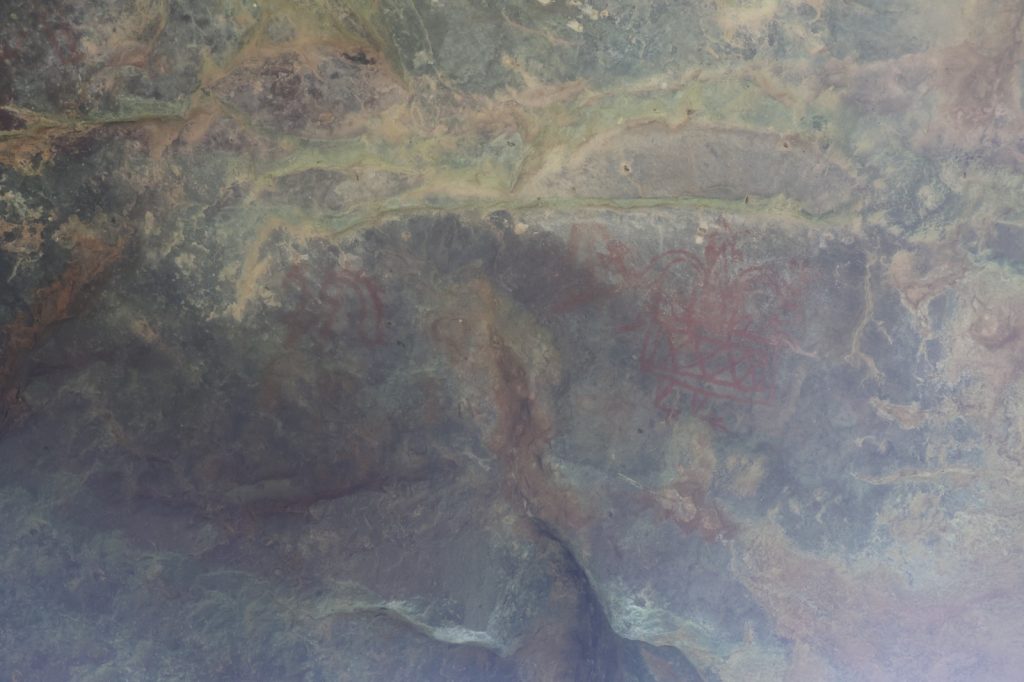
After successive governments’ apathy towards the need for conservation, a ray of hope emerged after the Apex Court directed the Haryana govt to ensure that no damage is caused at the Aravalli site where the ASI has set up a team to study Palaeolithic era stone carvings, writes Aayush Goel
It takes an 80-minute trek through the terrain lined with thorny bushes, sharp rocks and slippery pebbles near Badshahpur Tethar village of Sohna in Gurugram, Haryana to reach atop what seems like yet another dying hillock of the Aravali range. A closer look at it reveals graffiti, hand and footprints of humans and animals and it takes a while to realise that we are looking at what could be a pre-Palaeolithic petroglyph spread across a 2 km radius. The Paleolithic era spans from about 25 lakh years to 10,000 BP (before present, the carbon dating marker that archaeologists use with 1950 treated as the base year).
Discovered in 2023, the site lies unattended in utter negligence and symbolises the poor state of Aravalis which may hold troves of archaeological treasure but is awaiting its due recognition and attention.
Prior to this, in 2021 the famous cave paintings were discovered in Mangar grove in Faridabad and while it caught national attention and was even compared to Bhimbetka caves, they too lie unconserved. There might have been, and could still be, more treasures waiting to be discovered in ancient ranges.
Much might have been lost to mining, ground to dust in the cavernous pits carved into the hills, but nobody seems to care in the state of Haryana. With no major progress made in either surveying or protecting prehistoric sites discovered in Aravalis, around 5000 hectares of the archaeologically valuable land lies vulnerable to encroachment and damage. It may be noted that around 20 pre historic sites have so far been discovered but all face the same threats from deterioration, illegal visits, theft and encroachment by the mining mafia.
“Aravalis is an archaeological treasure awaiting to be discovered. These sites are precious and we have written to authorities for umpteen times but nothing has happened on ground for the conservation. In addition to threats like weather, there are challenges of these being lost to thefts, illegal mining and land mafia. With word spreading around, many visitors visit these sites on their own and take away stones which may be of great archaeological value,” says Sunila Hasrana, a local ecologist who has discovered the majority of these sites, while speaking to Tehelka.
The state has since 2021 on various occasions announced a detailed carbon dating and survey, but continues to sit over the same announcing new projects like Jungle safari, while the locals and ecologists are fighting to safeguard the national treasure hidden in these hills. The Aravallis have been a subject of pre-historic research for several decades. In 1986, stone paintings were discovered in the Anangpur area of Faridabad. A total of 43 sites were traced then, prompting researchers to start surveys of the area every now and then.
Mangar Bani cave paintings
In 2021, the archaeological department acknowledged the discovery of a 5,000-hectare site in Faridabad’s Mangar, where cave paintings were found along with rock shelters and tools. Among the items that were found were pebbles and flake-based tools, hinting at a site where stone tools were manufactured — this ‘Acheulean’ industry was the first tradition of standardised tool-making, according to archaeologists. They also believe that the Mangar stone paintings could be the largest in the Indian subcontinent. The caves are nestled amid a maze of quartzite rocks in the Aravalli mountain ranges and locals have been aware of them for decades while it was in 2021 that Haryana government’s museum and archaeology department took note of them. Despite initial plans and announcements these paintings are yet to be dated.
Archaeologists in Haryana have estimated that a prehistoric site Faridabad’s Mangar Bani hill forest, from where cave paintings were discovered recently, may be up to a lakh years old.
“On the basis of tool topology, it can be said that the date of prehistoric habitation at the site may be from about 1,00,000 to about 15,000 years ago. But we have also found evidence of later habitation, even up to 8th-9th century AD,” Banani Bhattacharyya, Deputy Director of Haryana Archaeology & Museums Department told Tehelka. “It can be said that it may be one of the biggest Palaeolithic sites in the Indian subcontinent, where Stone Age tools were recovered from different open air sites as well as from rock shelters”, she adds. These paintings are yet to be dated out.
After the discovery of these caves, the department sent a proposal for a detailed survey of about 5,000 hectares of Mangar Bani region and an announcement was also made about setting up of ecology forest and conserving the site under state protection to Mangar Bani forests under the Ancient and Historical Monuments and Archaeological Sites and Remains Act, 1964, but nothing ever materialised. Harsana said the paintings and the caves in which they are made have been a part of his life for many years, but it never struck him that they could be this old. It was a few pictures of these caves posted on social media during the lockdown that caught the attention of archaeologists and Haryana woke up to the treasure it was losing to mining and land mafia.
“The caves are in an area that is difficult to reach, so we have to plan before going. It is on a high cliff and the terrain is very difficult, it poses the maximum difficulty level in terms of climbing. This is probably why the caves and the art survived as well, because people don’t normally go there. Some of the caves have rock art while others have paintings, but only a few of the paintings are in good condition, the others have deteriorated. The art includes what appear to be symbols, markings, some are drawings that are very old, but what exactly it is, only the archaeology department will be able to tell,” he said.
Supreme Court steps in
While successive governments have slept over the need for conservation, a ray of hope emerged as the Supreme Court in November this year took cognizance of the same. The Supreme Court has directed the Haryana government to ensure that no damage is caused at the Aravalli site where the Archaeological Survey of India (ASI) has set up a team to study Palaeolithic era stone carvings and determine its antiquity through carbon dating.
A bench headed by Justice Sanjay Kishan Kaul passed the order on November 7. The court was informed that a five-member team of ASI will carry out carbon dating of the ancient stone carvings believed to be from the upper Palaeolithic era. The bench, also comprising Justice Sudhanshu Dhulia, said, “This area may require protection” as it issued notice to the Haryana government seeking response. Posting the matter for January 9, the bench said, “The state of Haryana will file a response on this behalf and ensure that if the news report is correct, no damage is caused in the area.”
“We have already submitted a detailed survey and conservation proposal and await the government’s nod on the same. This is the biggest archaeological trove in Delhi NCR and if we manage to tap the potential we will not just be able to conserve and revisit the history but will also have a major scope of archaeological tourism. Currently unregulated visits and safaris to these sites are being held and sooner we stop it and take reigns, the better for the state and these sites,” added Banani.













